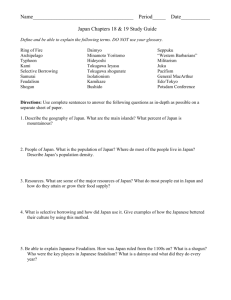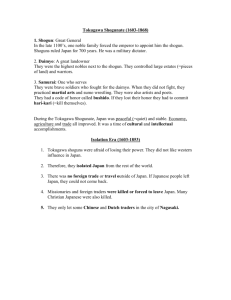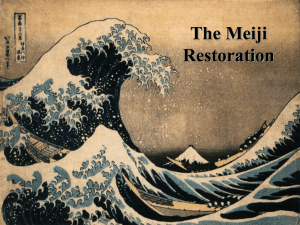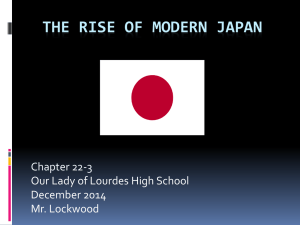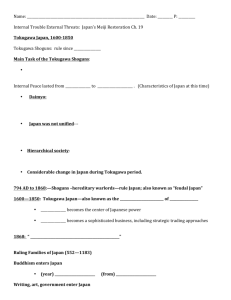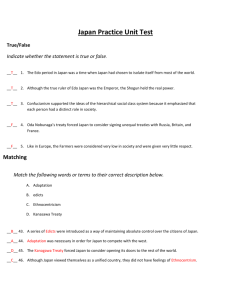Japan Modernizes - rivard
advertisement
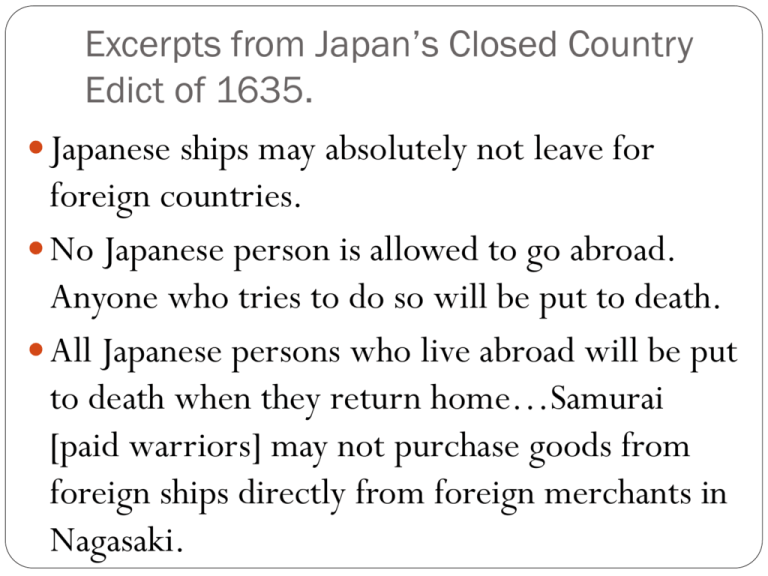
Excerpts from Japan’s Closed Country Edict of 1635. Japanese ships may absolutely not leave for foreign countries. No Japanese person is allowed to go abroad. Anyone who tries to do so will be put to death. All Japanese persons who live abroad will be put to death when they return home…Samurai [paid warriors] may not purchase goods from foreign ships directly from foreign merchants in Nagasaki. Questions What policy did the Closed Country Edict Establish? How did this affect Japanese traders? Questions How do you think foreign powers will react to Japan’s isolationism? Japan Modernizes Japan Before Modernization Before the late 17th century, Japan had virtually no contact with industrialized nations. They traded with China and some Dutch traders from Indonesia and had a diplomatic relationship with Korean, but otherwise they were shut off from the rest of the world. Japan Before Modernization Japan was under the rule of Tokugawa shoguns, and they had a strictly ordered society. Shogun=a supreme military commander who ruled in the name of the emperor Shoguns distributed land to landlords. Peasants worked for the landlords and were protected by them and their samurai. Tokugawa Yoshinobu, the last Tokugawa shogun, in French military dress (1867) Tokugawa Ieyasu, the first Tokugawa shogun, ruled from 1603-1605 Japan Before Modernization Women were very restricted, their duty was to remain in the home and raise sons. “A woman has no other lord; she must look to her husband as her lord and must serve him with all worship and reverence…” ~Kaibara Ekken (c. 1729) Japan Before Modernization Japanese society was very restrictive, but they were prosperous and had a peaceful life. Demands of Foreign Trade Like China in the early th 19 centuries, western countries were trying to convince Japan to open their ports and trade. Unlike China, Japan completely refused to trade with anyone. Demands of Foreign Trade In 1853, Commodore Matthew Perry of the US navy showed up in one of Japan’s harbors with four ships. Demands of Foreign Trade The Japanese were awed by these ships and realized their samurai and methods of defense were completely outdated. The Letter Commodore Perry came to Japan to bring a letter from President Fillmore, politely asking Japan to begin trading. Perry said he would return in a year, with an even larger fleet to receive Japan’s reply. The Letter This led to Japan signing the Treaty of Kanagawa in 1854 which opened two ports, and let the US set up an embassy in Japan. This led to extraterritorial rights and more foreigners in the country by the 1860’s. Japan Reforms The Japanese people were angry that their country had been given over to foreigner’s demands. People began to put their support in Emperor Mutsuhito, because he appealed to people’s pride and nationalism. Japan Reforms In 1867 the Tokugawa shogun stepped down, and this allowed Mutsuhito to create a new government. Mutsuhito was 15 when he took over. He ruled from 1867 – 1912 and this was known as the Meiji Era. Japan Reforms Mutsuhito named his new government Meiji which means enlightened rule. Meiji Era The emperor realized that the best way to oppose western ways was to modernize. All land was given to the emperor, and owned by him. Meiji Era Representatives were sent to foreign countries to study their ways. The Japanese chose what they believed were the best societies and militaries and modeled themselves based off that. Foreign Ideas Germany – the Japanese liked the way Germany had a strong centralized government where a small group of men had political power. They also liked how strong Germany’s army was, so they modeled these aspects of their country after the Germans. Foreign Ideas Britain – the Japanese admired the British navy greatly, and they attempted to create a similar one. United States – they admired the American school system, and created free public schools and required all the children to go in order to be more educated citizens. They included foreign experts and often encouraged people to study abroad. Industrialization The emperor realized it was also important for Japan to industrialize. By 1872, Japan had built their first railroad. By 1914, Japan had more than 7,000 miles of rails. Industrialization Coal production greatly increased. The state supported other means of production and those increased greatly as well. Japan continued to produce commodity products like tea, and silk for trade. They also began weapon/military development. JAPANESE IMPERIALISM Question and Answer-10 minutes QUESTIONS Using your notes, answer the following questions (1 sentence each): Why did the Japanese imperialize? Why did Japan attack China? What was the outcome? Why did Japan go to war with Russia? What was the outcome of this conflict? Why did Japan take over Korea? What was Korea like under Japanese rule? Exam Review Studying should focus on imperialism since you have already been quizzed on industrialization. Make sure to look at vocab and unit questions Are there any questions pertaining to industrialization and/or imperialism?



